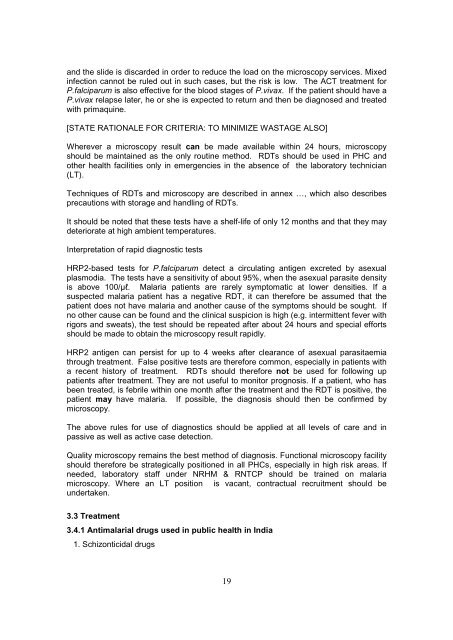Training Module for Medical Officer - NVBDCP
Training Module for Medical Officer - NVBDCP
Training Module for Medical Officer - NVBDCP
You also want an ePaper? Increase the reach of your titles
YUMPU automatically turns print PDFs into web optimized ePapers that Google loves.
and the slide is discarded in order to reduce the load on the microscopy services. Mixedinfection cannot be ruled out in such cases, but the risk is low. The ACT treatment <strong>for</strong>P.falciparum is also effective <strong>for</strong> the blood stages of P.vivax. If the patient should have aP.vivax relapse later, he or she is expected to return and then be diagnosed and treatedwith primaquine.[STATE RATIONALE FOR CRITERIA: TO MINIMIZE WASTAGE ALSO]Wherever a microscopy result can be made available within 24 hours, microscopyshould be maintained as the only routine method. RDTs should be used in PHC andother health facilities only in emergencies in the absence of the laboratory technician(LT).Techniques of RDTs and microscopy are described in annex …, which also describesprecautions with storage and handling of RDTs.It should be noted that these tests have a shelf-life of only 12 months and that they maydeteriorate at high ambient temperatures.Interpretation of rapid diagnostic testsHRP2-based tests <strong>for</strong> P.falciparum detect a circulating antigen excreted by asexualplasmodia. The tests have a sensitivity of about 95%, when the asexual parasite densityis above 100/µl. Malaria patients are rarely symptomatic at lower densities. If asuspected malaria patient has a negative RDT, it can there<strong>for</strong>e be assumed that thepatient does not have malaria and another cause of the symptoms should be sought. Ifno other cause can be found and the clinical suspicion is high (e.g. intermittent fever withrigors and sweats), the test should be repeated after about 24 hours and special ef<strong>for</strong>tsshould be made to obtain the microscopy result rapidly.HRP2 antigen can persist <strong>for</strong> up to 4 weeks after clearance of asexual parasitaemiathrough treatment. False positive tests are there<strong>for</strong>e common, especially in patients witha recent history of treatment. RDTs should there<strong>for</strong>e not be used <strong>for</strong> following uppatients after treatment. They are not useful to monitor prognosis. If a patient, who hasbeen treated, is febrile within one month after the treatment and the RDT is positive, thepatient may have malaria. If possible, the diagnosis should then be confirmed bymicroscopy.The above rules <strong>for</strong> use of diagnostics should be applied at all levels of care and inpassive as well as active case detection.Quality microscopy remains the best method of diagnosis. Functional microscopy facilityshould there<strong>for</strong>e be strategically positioned in all PHCs, especially in high risk areas. Ifneeded, laboratory staff under NRHM & RNTCP should be trained on malariamicroscopy. Where an LT position is vacant, contractual recruitment should beundertaken.3.3 Treatment3.4.1 Antimalarial drugs used in public health in India1. Schizonticidal drugs19
















